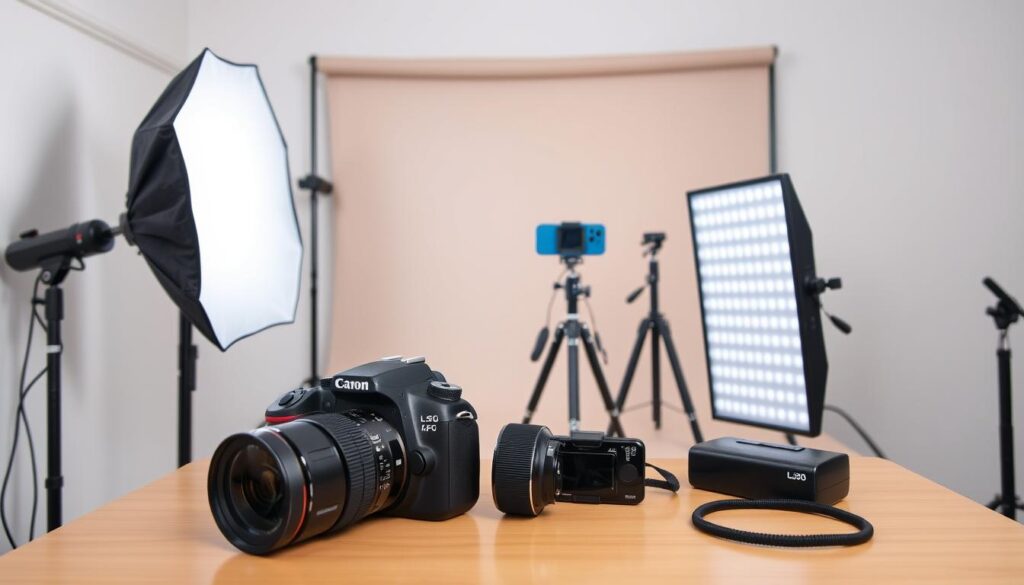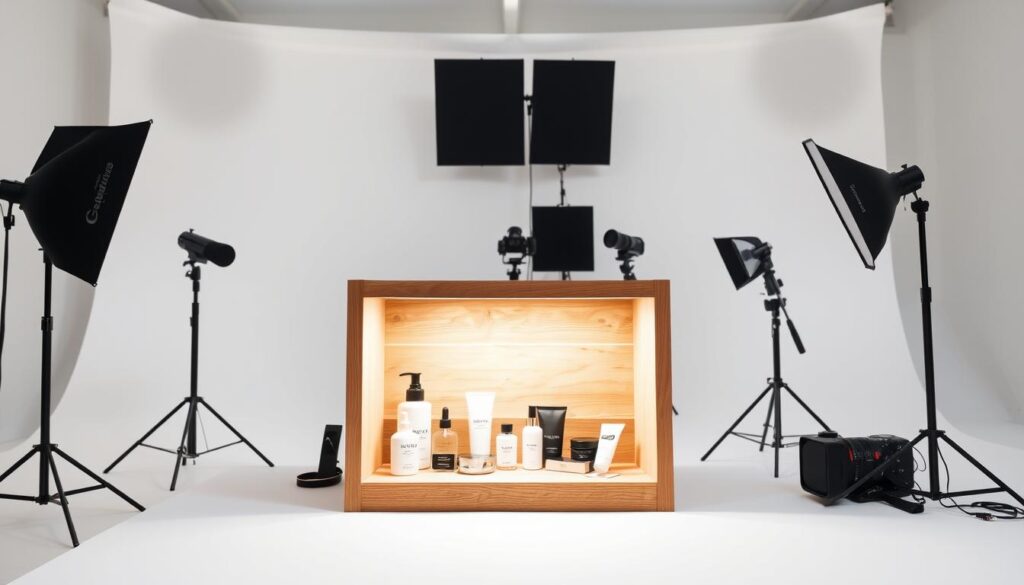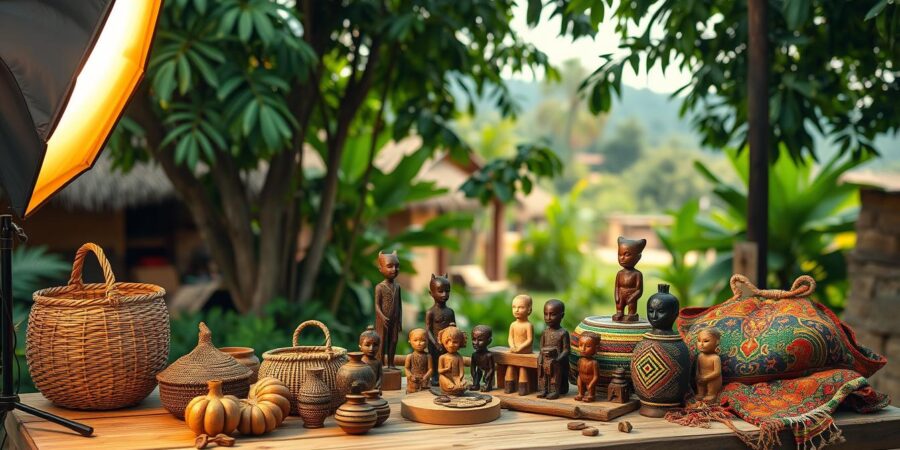Great product photos are crucial for online sales. In Tanzania, professional product photography is essential for attracting customers. This guide will show you how to make eye-catching e-commerce photos without spending a lot. Even with basic tools, you can create high-quality photos that showcase your items and build trust with buyers.
Whether you sell handmade crafts, electronics, or fashion, these tips are for you. Learn to use local resources like affordable backdrops or natural light for compelling online sales images. Discover how small adjustments in setup and composition can turn average shots into professional product photography that stands out in crowded marketplaces.
Key Takeaways
- High-quality product photos drive customer trust and increase online sales.
- Simple tools and local materials can achieve professional product photography results.
- Natural light and basic equipment are cost-effective for e-commerce photos.
- Visual consistency across product lines improves brand recognition.
- Editing basics help refine images without needing expensive software.
Essential Photography Equipment for Tanzanian Online Sellers
Creating stunning product photos doesn’t need to cost a lot. Start with what you have, like your smartphone. It’s great for smartphone photography. Add some affordable tools to make a budget photography setup for your business.

Budget-Friendly Camera Options
Look at camera options Tanzania has. Shops like Simba Electronics and Kariakoo markets have entry-level DSLRs. For under TSh 500,000, you can find good cameras. Even smartphones with 48MP+ cameras work well with clip-on macro lenses.
Steady Shots with Tripods
- Tabletop tripods (under TSh 100,000) keep small products steady.
- Portable carbon fiber models at Simba Electronics are great for mid-sized items.
- Adjustable arms help get detailed shots.
DIY Backdrop Solutions
Try DIY product photography tricks. For smooth backgrounds:
- Kitenge fabric adds color and cultural flair.
- Colored paper from Uchumi Stationery shops makes clean backdrops.
- White foam board reflects light and makes editing easier.
Tools to Boost Quality
Use these budget-friendly tools to improve your setup:
- Battery-operated ring lights (e.g., from Simba Electronics) for steady lighting.
- Aluminum foil + cardboard = DIY reflectors.
- Clip-on smartphone lenses (fisheye/macro) for close-ups.
Every tool here can turn simple items into a pro setup. Focus on quality, not quantity, to stay within budget.
Mastering Lighting for Product Photography
Natural lighting is key. Place products near windows for soft light during golden hours. Use white bedsheets or paper to soften sunlight. In Dar es Salaam markets or Arusha workshops, this method avoids harsh shadows.

For indoor lighting, make DIY setups with local materials. Use cardboard and aluminum foil as reflectors. In Mwanza or Morogoro, build a light box Tanzania with translucent plastic and LED strips. Here’s how:
- Cut a cardboard box to size
- Line the interior with white paper
- Add soft LED lights on two sides
- Use a translucent white cloth as a lid
“Lighting turns ordinary items into standout visuals. Even with limited resources, creativity shines.” —Local photographer, Tanga-based seller
Battery-powered LED panels are great for power outages. For textiles or crafts, diffuse window light to show textures. Jewelry and small items look best in a light box Tanzania for even light. Adjust your setup based on the product and space. Consistent lighting builds trust in your listings.
How to Take High-Quality Photos Through Proper Composition
Good product photography in Tanzania begins with strong composition. These tips help sellers make images that grab buyers’ attention and build trust online. Let’s look at simple methods for local products.
Product Positioning Techniques
- Rule of thirds: Place items off-center for dynamic shots of carvings or kanga textiles.
- Use negative space for items like handcrafted bowls to highlight their shape and craftsmanship.
- Center symmetric products like beadwork jewelry to emphasize detail.
Capturing Multiple Angles
Photography angles are key for complex items. Shoot:
- Frontal views for beadwork patterns.
- Side angles to show carvings’ depth.
- Overhead shots of agricultural produce to display quantity and quality.
Using Props to Create Context and Scale
Incorporate props found in local markets:
- Use woven baskets as backgrounds for pottery.
- Add coins or hands to show scale for small crafts.
- Place spices in traditional containers to highlight origin and use.
Creating Visual Consistency
Consistent product imagery builds brand recognition. Use:
- Same lighting setups for all product categories.
- Neutral backgrounds like plain fabrics for textiles and carvings.
- Uniform styling for similar items to create cohesion on platforms like WhatsApp Business.
Photo Editing Basics for E-commerce Success
Even the best photos need a final touch. Mobile photo editing tools let you polish images without fancy computers. Start with free apps like Snapseed, Lightroom Mobile, or PicsArt—they work smoothly on basic smartphones.
- Snapseed: Crop, adjust brightness, and fix colors with its “Selective” tool.
- Lightroom Mobile: Sync settings across devices for consistent product lines.
- PicsArt: Use its “Magic Eraser” for quick basic photo retouching on small blemishes.
Edit smartly: Crop to focus on products, tweak white balance for true colors, and sharpen edges. For clothing, boost contrast; for food, warm up tones slightly. Always keep edits authentic—customers trust what they see.
Optimize images for fast loading. Use apps to resize photos to 800×800 pixels before posting. Platforms like Jumia or WhatsApp Business prefer smaller files without losing sharpness. Avoid heavy filters—natural looks drive more sales.
Practice with these smartphone editing tools daily. Small edits make big differences. Your products deserve to shine!
Conclusion: Implementing Your Product Photography Strategy
Creating a solid product photography workflow doesn’t need fancy equipment or complicated setups. Begin by making a checklist for each product type. List the angles, props, and lighting you’ll need before starting to avoid redoing shots.
For those juggling many tasks, take photos in batches during the best daylight hours. This makes your e-commerce photo strategy more efficient.
Organize your product photos using free tools like Google Drive or Dropbox. Tag files by product line and variant. Start with simple systems to ensure consistent brand imagery. Store original files in one folder and resized versions for online platforms in another.
For Tanzanian sellers, try DIY methods first. Then, as demand increases, consider partnering with local photographers like Dar es Salaam-based Visual Merchants Studio.
Start with small changes: update one product’s photos using natural window light this week. See how clearer images impact customer inquiries. Over time, improve your product photo management by trying different backdrop colors or adding lifestyle shots.
Even basic consistency across listings can build trust in crowded markets like Jumia or Twiga.
Remember, every step you take makes your brand look better to buyers. Focus on making progress, not aiming for perfection. With these tips, sellers from Arusha to Zanzibar can turn simple photos into eye-catching visuals that boost sales. Start today—your brand’s next growth spurt begins with one well-lit photo.
FAQ
What basic equipment do I need for product photography?
Start with a smartphone camera, which many Tanzanian sellers already have. For a dedicated camera, look at affordable point-and-shoots or entry-level DSLRs at Simba Electronics. Remember a sturdy tripod and local materials like kitenge fabrics or colored paper for backdrops.
How can I use natural light for my product photos?
Tanzania’s natural light can improve your photos. Take photos during the golden hours, early morning or late afternoon, for softer light. Set up near a window for the best light and use white sheets as diffusers to soften sunlight.
What are some simple composition techniques for better photos?
Use the rule of thirds, center your product, and negative space for better images. Show traditional items in a way that highlights their cultural value. This makes your photos more appealing.
How can I improve the consistency of my product images?
Keep similar lighting, backgrounds, and props in your photos for consistency. This creates a recognizable brand image on platforms like Facebook Marketplace and Instagram.
What editing apps are recommended for photo editing on smartphones?
Snapseed, Lightroom Mobile, and PicsArt are great for beginners. They let you adjust brightness, contrast, and white balance easily. This ensures your images meet e-commerce standards.
How do I optimize my photos for online platforms?
Each platform likes different image sizes. Instagram likes squares, while Facebook Marketplace prefers landscapes. Compress your images to balance quality and fast loading times, important in areas with slow internet.
Can you recommend ways to take multiple angles of a product?
Show different angles to highlight your product’s features and quality. Focus on angles that best represent the item. Use close-ups for details, side views for structure, and context shots for use.

Leave a Reply